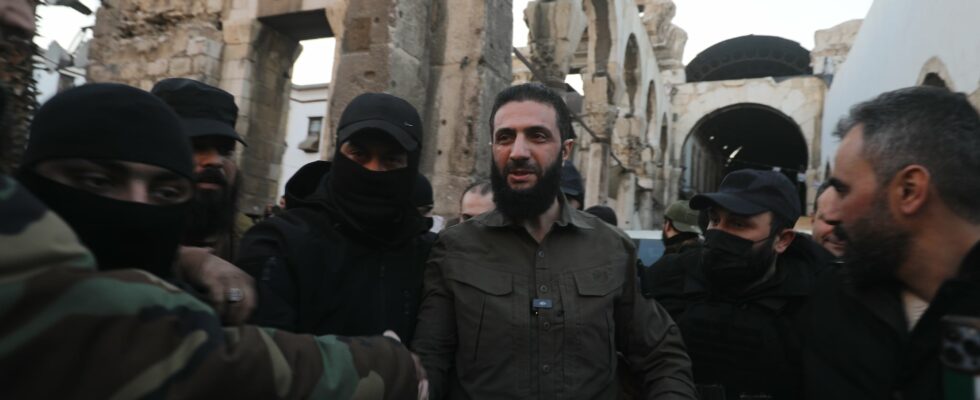Unit dedicated to drones, training of fighters, development of a military doctrine, regrouping of rebel factions… Many details on the carefully planned operation aimed at overthrowing the Syrian regime of Bashar al-Assad are now known. They were given on Friday by Abu Hassan al-Hamwi to the British newspaper The Guardian. The military commander of Hayat Tahrir Al-Sham (HTC), former head of the military branch of the Islamist group, explained at length behind the scenes of this operation which ended the 24 years of merciless rule of Bashar al-Assad.
Islamist rebels, who took the world by surprise by overthrowing the Syrian president in a lightning offensive, had planned the operation a year ago, the military commander revealed in his first interview with foreign media since the fall of the regime. But if the development of this operation called “repelling aggression” began twelve months ago, the group had in reality been preparing for it for years.
“The absence of unified leadership”
Since 2019, HTC has developed a military doctrine that allows it to transform fighters from disparate and disorganized opposition and jihadist groups into a disciplined fighting force. It was only at the end of November that he felt the time had come, particularly because of the international context. To do this, it was first necessary to unite the different rebel groups operating in the country. “The fundamental problem was the absence of a unified leadership,” Abu Hassan al-Hamwi, 40, told Guardian.
“After the last campaign [NDLR : en août 2019]”, during which we lost significant territory, all revolutionary factions became aware of the critical danger,” added the source, who has been overseeing HTC’s military wing for five years.
As the British daily recalls, in 2019, the Syrian regime launched an operation against opposition forces in northwest Syria, successfully pushing back loosely linked factions in Idlib province. After a final battle in which Turkey brokered a ceasefire on behalf of opposition forces in spring 2020, the rebels were confined to a small pocket of territory in northwest Syria .
“We have studied the enemy in depth”
As part of the preparation for the offensive, an operations room was created. This brought together the commanders of around 25 rebel groups located in southern Syria, who coordinated the movements of their fighters among themselves and with HTC, based in the north. The objective was for the HTC group and its allies to arrive in Damascus from the north of the country while the rebels would arrive from the south, with the two meeting in the Syrian capital.
Once the coalition was put together, with the HTC group as its spearhead, it set about training combatants and developing a military doctrine. “We studied the enemy in depth, analyzed its tactics, day and night, and we used this knowledge to develop our own forces,” Abu Hassan al-Hamwi said. Overwhelmed by the Assad regime, which has an air force and support from Russia and Iran, the group knew it had to get creative to make the most of resources limited.
The group, which was made up of insurgents, slowly transformed into a disciplined fighting force, describes the British newspaper. HTC also began producing its own weapons, vehicles and ammunition. In this context, a military unit dedicated to drones was created, bringing together engineers, mechanics and scientists. “We unified their knowledge and set clear objectives: we needed reconnaissance drones, attack drones and explosive drones, with an emphasis on range and endurance,” emphasized Abou Hassan Al- Hamwi, adding that their production began in 2019. These “explosive drones” nicknamed “Shahen” were deployed this month against the forces of the former Syrian president with devastating effectiveness. Military artillery vehicles have been neutralized by these cheap but extremely effective devices.
The surprise of seeing Aleppo fall so quickly
HTC launched the operation by entering Aleppo on November 29. Hezbollah fighters attempted to defend the city, but quickly withdrew. The rapid fall of the country’s second largest, which Bashar al-Assad’s regime took four years to wrest from the rebels in 2016, surprised the group. “We were convinced, and this was based on historical precedent, that Damascus could not fall until Aleppo had fallen,” said Hayat Tahrir Al-Sham military commander.
At the end of an 11-day offensive, the rebel coalition dominated by HTC overthrew the power of Bashar al-Assad on Sunday, December 8, who fled to Russia with his family, according to Russian agencies. A prime minister, Mohammad al-Bashir, was appointed Tuesday to lead a transitional government until March 1, 2025. Abu Hassan Al-Hamwi, originally an agricultural engineer graduated from the University of Damascus and displaced by the regime ‘el-Assad with his family in Idlib, for his part declared to Guardian that he would occupy a position within the new civilian government.
